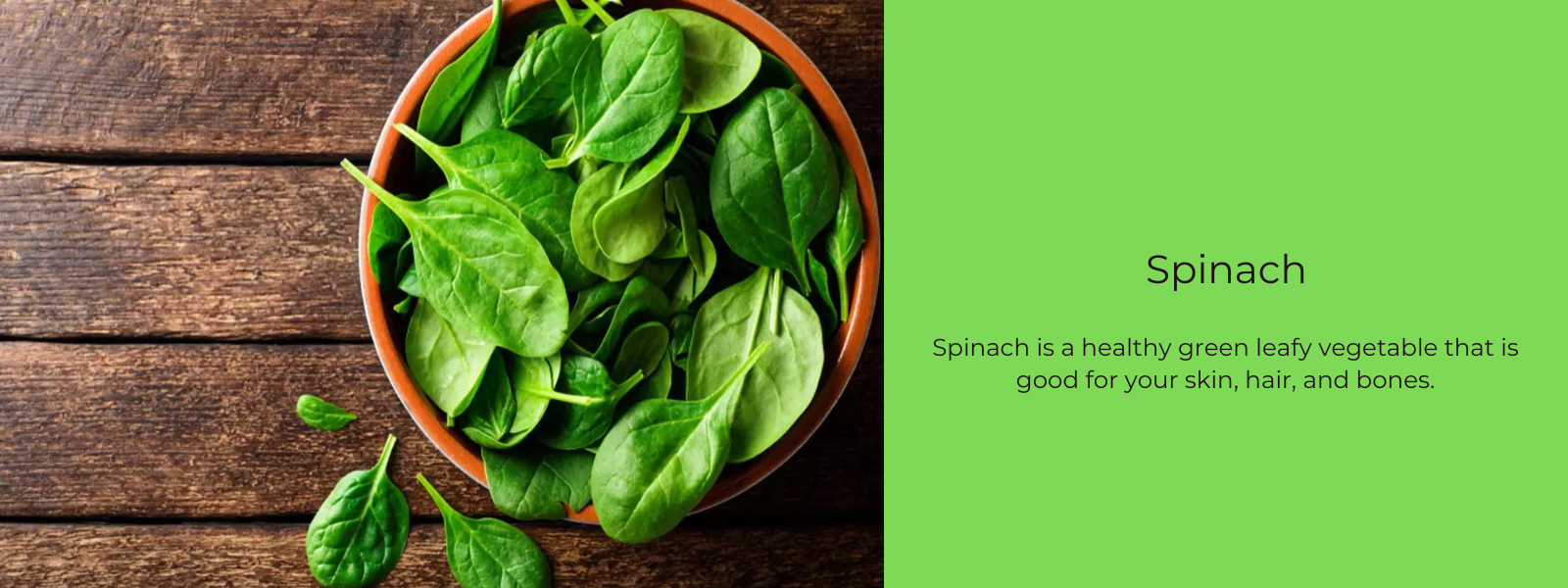Spinach is a nutrient-dense leafy green that is particularly high in vitamin A, mainly in the form of beta-carotene. One cup of raw spinach provides a substantial portion of the recommended daily intake of vitamin A. Consuming spinach regularly can help meet your vitamin A needs and offer various health benefits.
Table of Contents
Health Benefits of Spinach
- Nutrient-Rich Superfood
Spinach is brimming with essential nutrients like vitamins A, C, K, folate, iron, calcium, and magnesium. These vitamins and minerals are vital for various bodily functions and contribute to overall health.
- Eye Health Enhancement
Packed with lutein and zeaxanthin, spinach helps protect your eyes from harmful light rays and oxidative damage. These antioxidants support eye health by reducing the risk of conditions like macular degeneration and cataracts.
- Immune System Support
The high vitamin C content in spinach strengthens the immune system by promoting the production of white blood cells. It also acts as a powerful antioxidant, aiding in the body’s defense against infections and speeding up wound recovery.
- Skin Vitality
Spinach provides a boost to skin health through its vitamins A and C. Vitamin A aids in cell repair and maintenance, ensuring smooth and vibrant skin, while vitamin C supports collagen production, which helps to keep skin firm and youthful.
- Bone Strength
Vitamin K, abundant in spinach, plays a crucial role in maintaining bone health by supporting bone mineralization and density. Combined with calcium and magnesium, spinach helps in preventing bone-related issues like osteoporosis and fractures.
- Digestive Health
Spinach is a good source of dietary fiber, which promotes healthy digestion by adding bulk to stool and facilitating regular bowel movements. This helps prevent constipation and supports overall gut health.
- Cardiovascular Wellness
Spinach contains antioxidants like vitamin C and beta-carotene that help reduce inflammation and oxidative stress, which are linked to heart disease. Additionally, spinach’s nitrates can help lower blood pressure, benefiting cardiovascular health.
- Weight Control
Due to its low calorie and high fiber content, spinach is an excellent choice for those looking to manage their weight. The fiber helps you feel full and satisfied, making it easier to maintain a healthy weight.
- Anti-Inflammatory Properties
Spinach’s anti-inflammatory compounds, including omega-3 fatty acids and antioxidants like quercetin, help reduce inflammation throughout the body. This can help mitigate the risk of chronic inflammatory diseases.
- Cognitive Benefits
The nutrients in spinach, such as vitamin K and folate, are important for brain health. They help protect cognitive function, support mental clarity, and may reduce the risk of age-related cognitive decline.
Incorporating Spinach into Your Diet
Adding spinach to your diet is easy and can be done in a variety of delicious ways. This leafy green is versatile and can be included in meals throughout the day, from breakfast to dinner. Here are some popular and nutritious recipes that feature spinach:
- Spinach Smoothies
Start your day with a nutrient-packed smoothie. Blend fresh spinach with fruits like bananas, apples, or berries, along with a liquid base such as almond milk, yogurt, or coconut water. Add a scoop of protein powder or a tablespoon of chia seeds for an extra nutritional boost. The mild flavor of spinach blends well with fruits, making it a seamless addition to your morning routine.
Recipe: Spinach and Berry Smoothie
- 1 cup fresh spinach
- 1 banana
- 1/2 cup frozen berries
- 1 cup almond milk
- 1 tablespoon chia seeds (optional)
- 1 scoop protein powder (optional)
Blend all ingredients until smooth and enjoy!
- Spinach Salads
Spinach makes an excellent base for salads. Combine it with a variety of vegetables, fruits, nuts, and proteins to create a filling and nutritious meal. Spinach salads are a great way to get a hefty dose of vitamins and minerals.
Recipe: Spinach and Strawberry Salad
- 4 cups fresh spinach
- 1 cup sliced strawberries
- 1/4 cup crumbled feta cheese
- 1/4 cup sliced almonds
- 1/4 red onion, thinly sliced
- 2 tablespoons balsamic vinaigrette
Toss all ingredients together in a large bowl and serve.
- Sautéed Spinach
A quick and easy side dish, sautéed spinach can be prepared in minutes. Simply heat a bit of olive oil in a pan, add fresh spinach, and cook until wilted. Season with garlic, salt, and pepper to taste. This method preserves the nutrients in spinach while enhancing its flavor.
Recipe: Garlic Sautéed Spinach
- 1 tablespoon olive oil
- 2 cloves garlic, minced
- 6 cups fresh spinach
- Salt and pepper to taste
- Lemon juice (optional)
Heat the olive oil in a large pan over medium heat. Add garlic and sauté for about 1 minute. Add spinach and cook until wilted, about 3-4 minutes. Season with salt, pepper, and a squeeze of lemon juice if desired.
- Spinach in Pasta
Incorporate spinach into your favorite pasta dishes for added nutrition. It pairs well with a variety of sauces, from creamy Alfredo to tangy marinara. You can add fresh spinach to the pasta just before serving or blend it into the sauce for a smoother texture.
Recipe: Spinach and Ricotta Stuffed Shells
- 20 jumbo pasta shells
- 2 cups ricotta cheese
- 1 cup cooked spinach, chopped
- 1/2 cup grated Parmesan cheese
- 1 egg
- 2 cups marinara sauce
- 1 cup shredded mozzarella cheese
- Salt and pepper to taste
Preheat the oven to 375°F (190°C). Cook pasta shells according to package instructions. In a bowl, mix ricotta, spinach, Parmesan, egg, salt, and pepper. Fill each shell with the ricotta mixture and place in a baking dish. Pour marinara sauce over the shells and top with mozzarella. Bake for 25-30 minutes until bubbly and golden.
- Spinach in Soups and Stews
Adding spinach to soups and stews is an easy way to boost the nutritional content of these dishes. Simply stir in fresh spinach towards the end of the cooking time to retain its vibrant color and nutrients.
Recipe: Spinach and White Bean Soup
- 1 tablespoon olive oil
- 1 onion, chopped
- 2 cloves garlic, minced
- 1 carrot, diced
- 1 celery stalk, diced
- 4 cups vegetable broth
- 2 cans white beans, drained and rinsed
- 4 cups fresh spinach
- 1 teaspoon thyme
- Salt and pepper to taste
Heat olive oil in a large pot over medium heat. Add onion, garlic, carrot, and celery, and cook until softened, about 5 minutes. Add broth, beans, thyme, salt, and pepper. Bring to a boil, then reduce heat and simmer for 20 minutes. Stir in spinach and cook until wilted, about 2-3 minutes.
Conclusion
Spinach is a highly versatile and nutrient-rich vegetable that offers significant health benefits due to its high vitamin A content. From enhancing vision and immune function to promoting healthy skin and supporting reproductive and bone health, vitamin A plays a crucial role in maintaining overall well-being. By incorporating spinach into your diet, you can take advantage of these benefits, helping to protect against various health issues and ensuring proper bodily functions. Enjoy spinach in salads, smoothies, soups, and other dishes to boost your vitamin A intake and support a healthier lifestyle.











Leave a comment